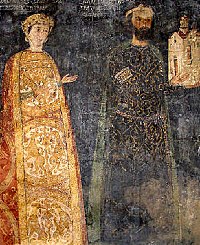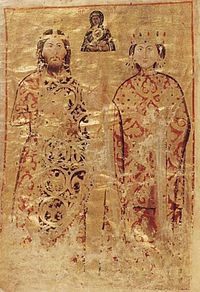Σεβαστοκράτωρ: Διαφορά μεταξύ των αναθεωρήσεων
partial rv of some weird changes: restoring consistent transliteration scheme & some changes for clarity |
removed Category:Royal and noble ranks using HotCat |
||
| Γραμμή 19: | Γραμμή 19: | ||
[[Category:Greek noble titles]] |
[[Category:Greek noble titles]] |
||
[[Category:Serbian noble titles]] |
[[Category:Serbian noble titles]] |
||
[[Category:Royal and noble ranks]] |
|||
[[bg:Севастократор]] |
[[bg:Севастократор]] |
||
Έκδοση από την 22:49, 22 Μαρτίου 2011


Sebastokratōr (ελληνικά: σεβαστοκράτωρ, Bulgarian and Serbian Севастократор; both pronounced sevastokrator) was a senior court title in the late Byzantine Empire. It was also used by other rulers whose states bordered the Empire or were within its sphere of influence. The word is a compound of "sebastos" ("venerable", the Greek equivalent of the Latin Augustus and "kratōr" ("ruler", the same element as is found in "autokratōr", "emperor"). The wife of a sebastokratōr was named sebastokratorissa (σεβαστοκρατόρισσα) in Greek or sebastokratitsa (севастократица) in Serbian and Bulgarian.
The title was created by Emperor Alexios I Komnenos (r. 1081–1118) to honour his elder brother Isaac.[1] According to Anna Komnene, Alexios did this to raise Isaac above the rank of Caesar, which he had already promised to his brother-in-law, Nikephoros Melissenos. Anna Komnene calls the rank of sebastokratōr that of "a second Emperor", and also records that along with the Caesar a sebastokratōr was granted the right to wear a crown (but not the imperial diadem).[2] During the Komnenian dynasty, the title continued to be the highest below that of Emperor until 1163, when Emperor Manuel I created the title of despotēs. It was at that period given exclusively to members of the imperial family, chiefly younger sons of the emperor.[1]
After the occupation of the Empire by the leaders of the Fourth Crusade in 1204, the title was adopted in the Latin Empire, the Empire of Nicaea, and the Bulgarian Empire. In Nicaea and the post-1261 restored Empire the title remained one of the highest, and was almost always restricted to members of the imperial family. The last known holder of the title was Demetrios Kantakouzenos, a ruler in the Peloponnese in the late 14th century.[1]
According to the sources, the distinctive colour associated with the title was blue: the sebastokratōr's ceremonial costume included blue stockings and blue boots. In ca. 1260 according to George Akropolites the sebastokratores who were members of the imperial family were distinguished from those who were not by having embroidered golden eagles on their shoes.[3] By the time of pseudo-Kodinos in the mid-14th century, the embroidered eagles on a red field were standard. According to Kodinos, the ceremonial costume also included a red tunic (chlamys) and crown (stephanos, not the diadem) of red and gold.[4] The sebastokratōr also had the prerogative of signing documents with a special blue ink.[1]
This title was used in Serbia during the Kingdom of Raška and during the Serbian Empire.
References
- ↑ 1,0 1,1 1,2 1,3 Kazhdan, Alexander, επιμ. (1991). Oxford Dictionary of Byzantium. Oxford University Press. σελ. 1862. ISBN 978-0-19-504652-6.
- ↑ Anna Komnene, Alexiad, III.4
- ↑ Macrides, Ruth (2007), George Akropolites: The History - Introduction, translation and commentary, Oxford University Press, σελ. 350, 366–367, ISBN 978-0-19-921067-1
- ↑ Parani, Maria G. (2003). Reconstructing the reality of images: Byzantine material culture and religious. iconography (11th to 15th centuries). BRILL. σελίδες 63, 67–69, 72. ISBN 978-9004124622.
